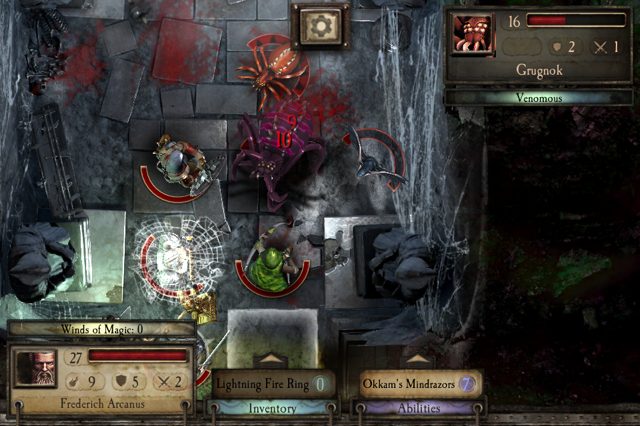Warhammer Quest (iOS)

Before I tell you why Rodeo Games’ Warhammer Quest is my favorite game of 2013, here’s a bit of background.
The original Warhammer Quest was a board game released by Games Workshop in 1995. Although it was only in print for a few years, the game developed a rabid following. Like Games Workshop’s earlier effort HeroQuest, it was a D&D-lite, turn-based adventure where a Barbarian, Wizard, Elf and Dwarf explored dungeons, slaying monsters and collecting treasure.
Rodeo Games’ previous iOS efforts are Hunters: Episode One and its impressively polished sequel, Hunters 2. Both are turn-based, top-down-view tactical adventures where your team of space mercenaries battles enemies across a series of beautifully-rendered tiled landscapes.
Sensing a chocolate-peanut butter relationship yet?
Warhammer Quest is, believe it or not, the third game of its particular subgenre to whet dungeon-delvers’ appetites on iOS this year. Dark Quest was a meager hors d’oeuvre. Mighty Dungeons was a filling, if uninspired, side dish. But Warhammer Quest is the gourmet entree we’ve been salivating for, both delicious and nourishing.
Alright, the metaphor kinda went off the rails there. But you get the idea.
I’m not surprised, given Rodeo’s track record, that Warhammer Quest gets so many things right. The visuals are the most immediately noticeable success: like the Hunters games, Warhammer Quest features gorgeously-rendered environments, with background details—like moss growing on the walls—adding atmosphere to the dungeons. The same is true of the lighting, which creates vivid yellows, pinks and greens amid the dank environs. Instead of abstract tokens, heroes and enemies are well-animated models, whose differing armor and weapons make them easily distinguishable. There’s real weight to actions; you can feel the thud of your Dwarf’s massive hammer felling a River Troll. The soundtrack is suitably epic during combat sequences and moody during exploration. (And it features a string riff I swear is lifted from Christopher Nolan’s Batman movies.) On my iPhone 4S, the Warhammer Quest performed generally smoothly, barring a few crashes. Be warned: This resource-intensive app will drain your battery in a hurry.
Presentation is only part of a game’s success, of course. But in Rodeo’s games, the high production value speaks to the attention to detail evident in the design. There’s nothing revolutionary about Warhammer Quest’s mechanics—each character can move a certain number of spaces and attack a certain number of times per turn before the monsters get a go, rinse and repeat—but they are executed so solidly and intuitively that the rhythm of play feels almost immediately familiar.
The slick user interface helps. Tap your hero to select him, and the tiles he can move to are highlighted in white. Enemies within melee distance are outlined in red; those within range of your bow, orange. An unobtrusive menu sits at the bottom of the screen, where you can view your character’s stats and select from items, abilities, and spells, without obscuring the field of battle. The interface is incredibly intuitive, freeing you to focus on tactics. In the game’s one big innovation—which I hope Rodeo patented, because look for every mobile RPG from now on to steal it—you tilt your device to portrait mode to display your inventory.
The elegant simplicity of the interface design also carries over into the narrative structure, such as it is. As you heroes complete quests, gain experience and acquire gear, you’ll discover new towns where you can trade, level up, gain buffs and recruit replacement heroes. (You’ll need to do the latter often on Hardcore difficulty, where hero death is permanent.) Respawning White Quests are sprinkled across the overworld map, allowing you to grind for levels or chase loot. A series of Red Quests serve as setpieces that culminate in a superbly-tense final dungeon. This last mission is one of the best “boss” encounters I’ve experienced in recent memory, requiring smart preparation and deft tactical improvisation.
